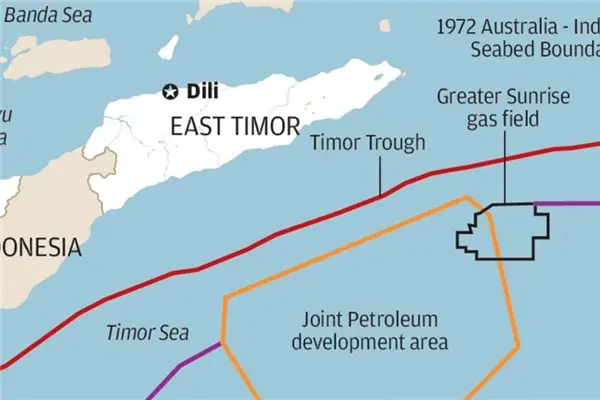Australia and East Timor have agreed to begin negotiations on a permanent maritime boundary between the two countries, potentially ending years of dispute over the lucrative oil-rich Timor Gap and closing a chapter of mistrust and enmity between the two neighbours.
Canberra and Dili have agreed to tear up the controversial Certain Maritime Arrangements in the Timor Sea (CMats) treaty that divides future revenue from the Greater Sunrise oil and gas reserve, where an estimated US$40 billion worth of oil and gas lies beneath the Timor Sea.
East Timor has sought to abandon the agreement for years, alleging it was unfairly negotiated because of Australian espionage.
A dispute over how to delineate the sea boundary between the two countries has marred relations since East Timor won its independence in 2002, but most acutely in 2012, when Australia was revealed to have spied on East Timor’s government by bugging its cabinet room under the pretext of renovations.
The two countries have been taking part in a year-long compulsory conciliation, overseen by the permanent court of arbitration (PCA) in The Hague, over the maritime boundary dispute. The conciliation is taking place behind closed doors, but, in an unprecedented move, the foreign affairs ministers of Australia and East Timor, along with the PCA, announced key developments in the negotiations on Monday.
Terminating the CMats treaty is a significant shift in position for Australia, which had maintained the treaty was valid and should remain in force. The treaty will cease to exist three months from East Timor’s formal notification.
The treaty established a temporary maritime boundary for 50 years. After terminating it, both countries have agreed to negotiate on a permanent boundary.
“The parties recognise the importance of providing stability and certainty for petroleum companies with interests in the Timor Sea and of continuing to provide a stable framework for petroleum operations and the development of resources in the Timor Sea,” the joint statement from foreign affairs ministers Julie Bishop and Hernâni Coelho said.
“The governments of East Timor and Australia have each confirmed to the other their commitment to negotiate permanent maritime boundaries under the auspices of the commission.”
Under the Law of the Sea and established state practice, any negotiation over a maritime boundary is likely to establish a boundary equidistant between the two countries , which would put the majority of the Greater Sunrise oil fields within East Timor’s territory.
However, Australia’s position has always been that the maritime boundary should lie closer to East Timor, at the edge of Australia’s continental shelf . That boundary would put Greater Sunrise under Australian control.
Australia’s demarcation at the edge of the continental shelf is not widely supported. The majority of international legal opinion supports the principle of equidistance .
The dispute over the Timor Sea has pre-empted and then overshadowed the short and chequered history between independent East Timor and Australia.
In 1975, as Portugal moved towards de-colonisation, the resistance movement Fretilin declared East Timor independent. Nine days later, the newly free nation was invaded by Indonesia’s military in breach of international law, and to widespread international condemnation.
In 1979 Australia became the only western nation to offer de jure recognition of Indonesia’s forced annexation, so the two countries could begin negotiations over the Timor Sea’s resources.
The Timor Gap treaty was signed (the then foreign affairs ministers Gareth Evans and Ali Alatas famously clinking champagne glasses in a plane above the Timor Sea) between Australia and Indonesia in 1989. That treaty did not establish a maritime boundary but provided for shared exploitation of petroleum resources in the part of the seabed claimed jointly by both countries.
Australia was East Timor’s saviour in 1999, leading the Interfet force which restored order in the country after the vote for independence and retribution by pro-Indonesia militias.
But in 2002, just two months before East Timor became independent, Australia secretly withdrew from the maritime boundary dispute resolution procedures of the UN convention on the law of the sea, and the equivalent jurisdiction of the international court of justice, so that it could not be compelled into legally binding international arbitration.
Australia has never formally admitted spying on East Timor during CMats negotiations, though it did raid the Canberra offices of East Timor’s lawyer Bernard Collaery , and seized the passport of the intelligence agent who blew the whistle on the spying operation.
(THE GUARDIAN)
 简体中文
简体中文

